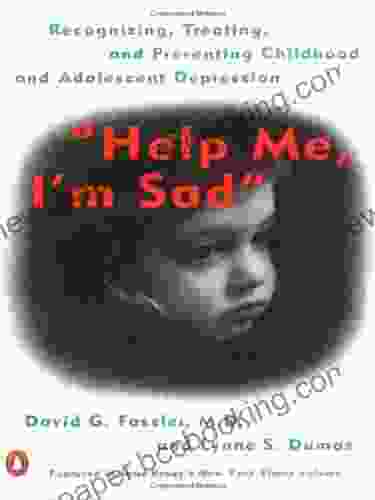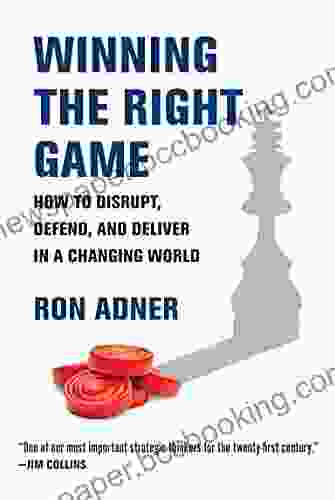Recognizing, Treating, and Preventing Childhood and Adolescent Depression: A Guide for Parents and Professionals

##
Depression is a serious mental health condition that can affect people of all ages, including children and adolescents. It is characterized by persistent feelings of sadness, hopelessness, and worthlessness. Depression can interfere with a child's or adolescent's ability to function in school, at home, and in social situations. If left untreated, depression can lead to serious problems, such as academic difficulties, relationship problems, and even suicide.
4.5 out of 5
| Language | : | English |
| File size | : | 1048 KB |
| Text-to-Speech | : | Enabled |
| Enhanced typesetting | : | Enabled |
| Word Wise | : | Enabled |
| Print length | : | 228 pages |
| Screen Reader | : | Supported |
The good news is that depression is treatable. With the right help, children and adolescents can recover from depression and go on to live happy, healthy lives. This book provides parents and professionals with the information they need to recognize, treat, and prevent depression in children and adolescents.
##
What is Depression?
Depression is a mental health condition that causes persistent feelings of sadness, hopelessness, and worthlessness. It can interfere with a person's ability to think, feel, and behave normally. Depression is not a sign of weakness or a character flaw. It is a real illness that requires treatment.
There are many different types of depression, including:
- Major depression: This is the most severe type of depression. It is characterized by persistent feelings of sadness, hopelessness, and worthlessness that last for two weeks or more. Other symptoms of major depression include:
- Loss of interest in activities that were once enjoyable
- Changes in appetite or weight
- Sleep problems
- Fatigue
- Difficulty concentrating
- Thoughts of death or suicide
- Persistent depressive disFree Download: This is a less severe type of depression that lasts for at least two years. Symptoms of persistent depressive disFree Download include:
- Persistent feelings of sadness, hopelessness, and worthlessness
- Loss of interest in activities that were once enjoyable
- Changes in appetite or weight
- Sleep problems
- Fatigue
- Difficulty concentrating
- Bipolar disFree Download: This is a mental health condition that causes alternating episodes of depression and mania. Symptoms of depression during a bipolar episode include:
- Persistent feelings of sadness, hopelessness, and worthlessness
- Loss of interest in activities that were once enjoyable
- Changes in appetite or weight
- Sleep problems
- Fatigue
- Difficulty concentrating
- Thoughts of death or suicide
##
What Causes Depression?
The exact cause of depression is unknown, but it is thought to be caused by a combination of genetic, biological, environmental, and psychological factors. Some of the risk factors for depression include:
- Having a family history of depression
- Experiencing a traumatic event, such as abuse, neglect, or the death of a loved one
- Having a chronic medical condition
- Using drugs or alcohol
- Being overweight or obese
- Having a sleep disFree Download
- Being exposed to toxins, such as lead or mercury
##
How is Depression Diagnosed?
Depression is diagnosed by a mental health professional, such as a psychiatrist, psychologist, or social worker. The mental health professional will ask about the person's symptoms, medical history, and family history. They may also Free Download blood tests or other tests to rule out other medical conditions that could be causing the person's symptoms.
##
How is Depression Treated?
There are a number of effective treatments for depression, including medication, psychotherapy, and lifestyle changes. The best treatment for a particular person will depend on their individual needs and preferences.
###
Medication
Antidepressants are the most common type of medication used to treat depression. Antidepressants work by increasing the levels of certain neurotransmitters in the brain, such as serotonin and norepinephrine. These neurotransmitters are involved in mood regulation.
There are a number of different types of antidepressants available, and each type works in a slightly different way. Some of the most common types of antidepressants include:
- Selective serotonin reuptake inhibitors (SSRIs): SSRIs are the most commonly prescribed type of antidepressant. They work by increasing the levels of serotonin in the brain.
- Serotonin-norepinephrine reuptake inhibitors (SNRIs): SNRIs work by increasing the levels of both serotonin and norepinephrine in the brain.
- Tricyclic antidepressants (TCAs): TCAs are an older type of antidepressant that is still sometimes used to treat depression. They work by increasing the levels of serotonin and norepinephrine in the brain.
- Monoamine oxidase inhibitors (MAOIs): MAOIs are an older type of antidepressant that is less commonly used today. They work by increasing the levels of serotonin, norepinephrine, and dopamine in the brain.
###
Psychotherapy
Psychotherapy is a type of talk therapy that can help people with depression learn how to manage their symptoms and improve their mood. There are a number of different types of psychotherapy that can be used to treat depression, including:
- Cognitive-behavioral therapy (CBT): CBT helps people with depression identify and change negative thoughts and behaviors that are contributing to their depression.
- Interpersonal therapy (IPT): IPT helps people with depression improve their relationships with others and learn how to cope with interpersonal problems.
- Psychodynamic therapy: Psychodynamic therapy helps people with depression explore their unconscious thoughts and feelings that may be contributing to their depression.
###
Lifestyle Changes
There are a number of lifestyle changes that people with depression can make to improve their mood, including:
- Getting regular exercise
- Eating a healthy diet
- Getting enough sleep
- Avoiding alcohol and drugs
- Connecting with others
- Managing stress
##
How Can I Help a Child or Adolescent with Depression?
If you think that a child or adolescent you know may be depressed, it is important to talk to them about it. Let them know that you are there for them and that you want to help. You can also encourage them to talk to a mental health professional.
There are a number of things you can do to help a child or adolescent with depression, including:
- Be supportive and understanding
- Encourage them to talk about their feelings
- Help them to find a mental health professional
- Accompany them to therapy appointments
- Help them to make lifestyle changes
- Monitor their progress and provide encouragement
##
How Can I Prevent Depression in Children and Adolescents?
There is no surefire way to prevent depression in children and adolescents, but there are a number of things you can do to reduce the risk, including:
- Create a supportive and loving home environment
- Encourage your child or adolescent to talk to you about their feelings
- Teach your child or adolescent how to cope with stress
- Encourage your child or adolescent to get regular exercise
- Make sure your child or adolescent is getting enough sleep
- Limit your child or adolescent's exposure to violence and other traumatic events
- Be aware of the signs and symptoms of depression
##
Depression is a serious mental health condition that can affect children and adolescents. However, it is important to remember that depression is treatable. With the right help, children and adolescents can recover from depression and go on to live happy, healthy lives.
If you think that a child or adolescent you know may be depressed, it is important to talk to them about it. Let them know that you are there for them and that you want to help. You can also encourage them to talk to a mental health professional.
4.5 out of 5
| Language | : | English |
| File size | : | 1048 KB |
| Text-to-Speech | : | Enabled |
| Enhanced typesetting | : | Enabled |
| Word Wise | : | Enabled |
| Print length | : | 228 pages |
| Screen Reader | : | Supported |
Do you want to contribute by writing guest posts on this blog?
Please contact us and send us a resume of previous articles that you have written.
 Book
Book Novel
Novel Page
Page Chapter
Chapter Text
Text Story
Story Genre
Genre Reader
Reader Library
Library Paperback
Paperback E-book
E-book Magazine
Magazine Newspaper
Newspaper Paragraph
Paragraph Sentence
Sentence Bookmark
Bookmark Shelf
Shelf Glossary
Glossary Bibliography
Bibliography Foreword
Foreword Preface
Preface Synopsis
Synopsis Annotation
Annotation Footnote
Footnote Manuscript
Manuscript Scroll
Scroll Codex
Codex Tome
Tome Bestseller
Bestseller Classics
Classics Library card
Library card Narrative
Narrative Biography
Biography Autobiography
Autobiography Memoir
Memoir Reference
Reference Encyclopedia
Encyclopedia Justine Picardie
Justine Picardie Julian Baggini
Julian Baggini Stephen K Hayes
Stephen K Hayes Monica Weis
Monica Weis Richard Isanove
Richard Isanove Walter Harding
Walter Harding Kai Harris
Kai Harris Julia Indichova
Julia Indichova Tarry Lindquist
Tarry Lindquist Katarzyna Wac
Katarzyna Wac Judy Mundle
Judy Mundle Karl Evanzz
Karl Evanzz K Black
K Black Lauren Kahl
Lauren Kahl June Gilbank
June Gilbank Kyle Prue
Kyle Prue Karen Taborn
Karen Taborn Valentin Chmerkovskiy
Valentin Chmerkovskiy Rylie Dark
Rylie Dark Kate Hoskins
Kate Hoskins
Light bulbAdvertise smarter! Our strategic ad space ensures maximum exposure. Reserve your spot today!

 Winston HayesUnveiling Ottawa's Enigmatic Past: Ottawa Rewind of Curiosities and Mysteries
Winston HayesUnveiling Ottawa's Enigmatic Past: Ottawa Rewind of Curiosities and Mysteries Yasunari KawabataFollow ·5.9k
Yasunari KawabataFollow ·5.9k Chinua AchebeFollow ·3.2k
Chinua AchebeFollow ·3.2k T.S. EliotFollow ·6.4k
T.S. EliotFollow ·6.4k Harold BlairFollow ·12.3k
Harold BlairFollow ·12.3k Louis HayesFollow ·10.3k
Louis HayesFollow ·10.3k Ernest HemingwayFollow ·15.3k
Ernest HemingwayFollow ·15.3k Sean TurnerFollow ·7.3k
Sean TurnerFollow ·7.3k Roland HayesFollow ·4.6k
Roland HayesFollow ·4.6k

 Drew Bell
Drew BellLife and Death in West Africa: A Groundbreaking Account...
A Journey Through...

 Stanley Bell
Stanley BellMaster the Art of Fly Fishing Line Management: A...
Are you an avid fly...

 Ernest Powell
Ernest PowellUnleash Your Entrepreneurial Spirit: A Comprehensive...
In the competitive...

 Derrick Hughes
Derrick HughesMaster Your Ride: The Ultimate Guide to Road Bike...
Are you ready to elevate your cycling...

 Camden Mitchell
Camden MitchellUnveiling the Enchanting World of American Royals III:...
Embark on a Captivating Royal Saga: American...

 Richard Simmons
Richard SimmonsUnveiling the Secrets of Fly Tying: A Comprehensive...
In the realm of...
4.5 out of 5
| Language | : | English |
| File size | : | 1048 KB |
| Text-to-Speech | : | Enabled |
| Enhanced typesetting | : | Enabled |
| Word Wise | : | Enabled |
| Print length | : | 228 pages |
| Screen Reader | : | Supported |









